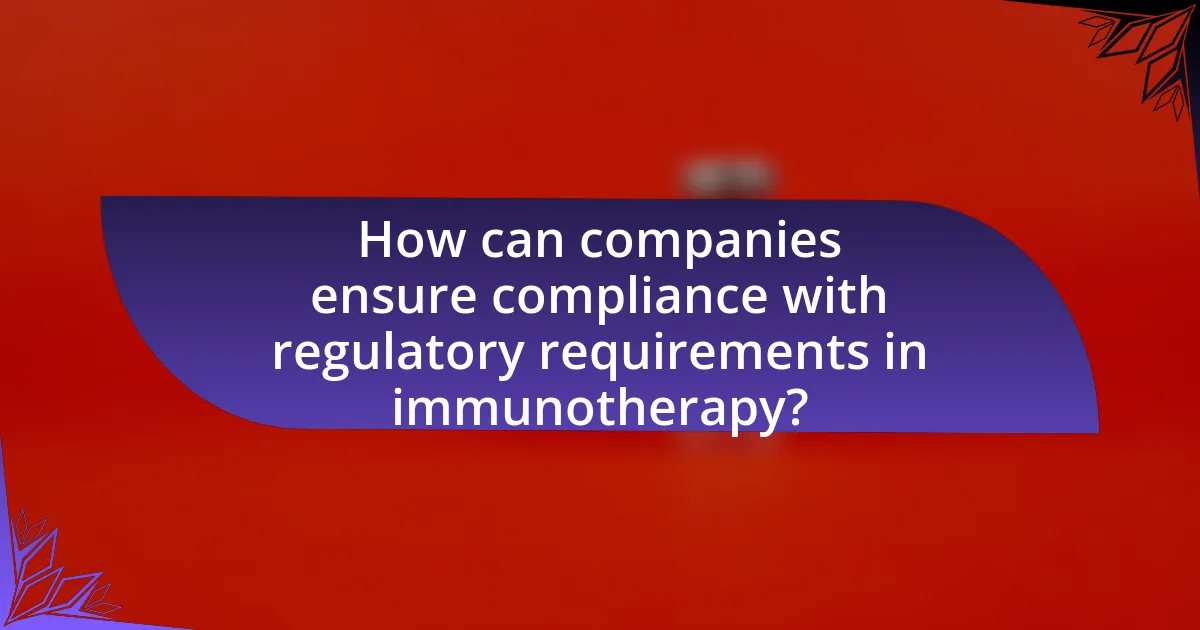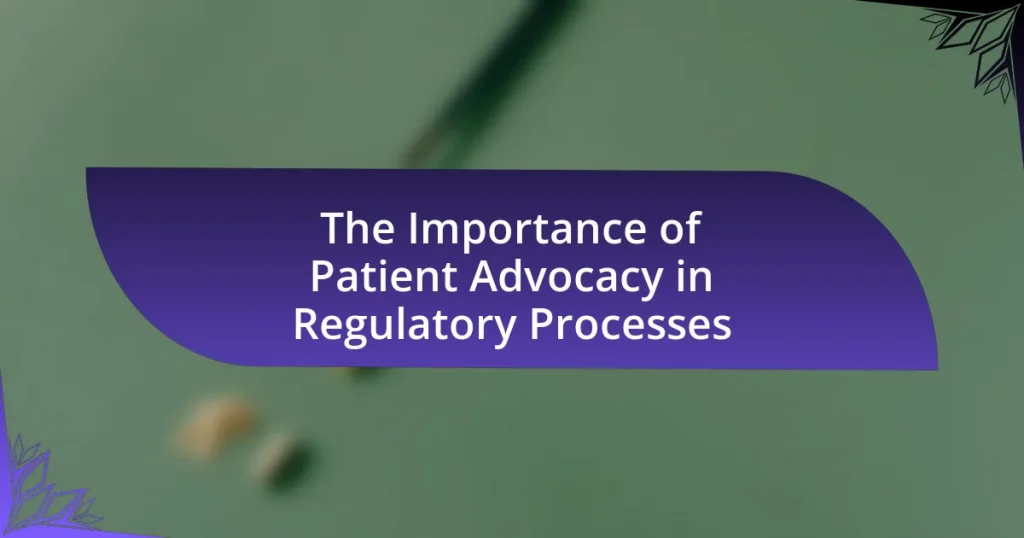The article focuses on best practices for regulatory submissions in immunotherapy, emphasizing the importance of thorough preclinical and clinical data collection, adherence to regulatory guidelines, and effective communication with regulatory agencies. It outlines the critical role of regulatory submissions in ensuring the safety and efficacy of new treatments, detailing the necessary documentation and data presentation required for successful approval. Additionally, the article addresses common challenges faced by companies, strategies to enhance compliance, and emerging trends in the regulatory landscape, including the integration of technology and real-world evidence. Overall, it provides a comprehensive overview of the regulatory submission process essential for advancing immunotherapy products.

What are the Best Practices for Regulatory Submissions in Immunotherapy?
The best practices for regulatory submissions in immunotherapy include thorough preclinical and clinical data collection, adherence to regulatory guidelines, and effective communication with regulatory agencies. Comprehensive preclinical studies should demonstrate the safety and efficacy of the immunotherapeutic agents, while clinical trials must follow Good Clinical Practice (GCP) standards to ensure data integrity. Regulatory guidelines, such as those from the FDA and EMA, provide frameworks for submission formats and required documentation, which must be meticulously followed to avoid delays. Additionally, maintaining open lines of communication with regulatory bodies can facilitate the submission process and address any concerns promptly. These practices are supported by the increasing number of successful immunotherapy approvals, highlighting the importance of rigorous compliance and proactive engagement in the regulatory landscape.
Why are regulatory submissions critical in the field of immunotherapy?
Regulatory submissions are critical in the field of immunotherapy because they ensure that new treatments are safe, effective, and meet established standards before reaching patients. These submissions provide comprehensive data on clinical trial results, manufacturing processes, and potential side effects, which regulatory bodies like the FDA or EMA evaluate to protect public health. For instance, the approval of CAR-T cell therapies, such as Kymriah and Yescarta, involved rigorous regulatory submissions that demonstrated their efficacy in treating certain types of cancer, ultimately leading to their market authorization.
What role do regulatory agencies play in immunotherapy development?
Regulatory agencies play a crucial role in immunotherapy development by ensuring the safety, efficacy, and quality of new treatments before they reach the market. These agencies, such as the U.S. Food and Drug Administration (FDA) and the European Medicines Agency (EMA), establish guidelines and requirements for clinical trials, which include preclinical studies, phase I, II, and III trials, to assess the therapeutic potential and risks associated with immunotherapies. For instance, the FDA’s 2018 guidance on the development of cell and gene therapies outlines specific considerations for the evaluation of these innovative treatments, emphasizing the need for robust data on safety and effectiveness. By enforcing regulatory standards, these agencies facilitate the approval process while protecting public health, ultimately fostering innovation in the field of immunotherapy.
How do regulatory submissions impact the approval process for immunotherapy products?
Regulatory submissions significantly influence the approval process for immunotherapy products by providing essential data that demonstrates safety and efficacy. These submissions, which include Investigational New Drug applications and Biologics License Applications, must adhere to stringent guidelines set by regulatory bodies like the FDA and EMA. For instance, the FDA requires comprehensive clinical trial data, which must show that the immunotherapy product meets specific endpoints related to patient outcomes. Failure to meet these requirements can lead to delays or rejections in the approval process. Historical data indicates that well-prepared submissions can expedite review timelines; for example, the FDA’s Breakthrough Therapy designation can shorten the approval process for promising immunotherapies. Thus, the quality and completeness of regulatory submissions are critical in determining the speed and success of the approval process for immunotherapy products.
What are the key components of a successful regulatory submission?
The key components of a successful regulatory submission include comprehensive data packages, clear and concise documentation, adherence to regulatory guidelines, and robust clinical evidence. Comprehensive data packages encompass all relevant preclinical and clinical data, ensuring that the submission presents a complete picture of the product’s safety and efficacy. Clear and concise documentation facilitates understanding and review by regulatory authorities, while adherence to regulatory guidelines ensures compliance with specific requirements set forth by agencies such as the FDA or EMA. Robust clinical evidence, supported by well-designed studies, is critical to demonstrate the therapeutic benefit and safety profile of the immunotherapy product. These components collectively enhance the likelihood of approval and expedite the regulatory review process.
What documentation is required for regulatory submissions in immunotherapy?
Regulatory submissions in immunotherapy require comprehensive documentation, including a clinical trial protocol, informed consent forms, investigator brochures, and data from preclinical studies. These documents ensure that the submission meets regulatory standards and provides evidence of safety and efficacy. For instance, the clinical trial protocol outlines the study design and methodology, while the informed consent forms ensure participant understanding and compliance. The investigator brochure contains essential information about the investigational product, and preclinical data supports the rationale for human trials. Collectively, these documents form the basis for regulatory review and approval processes.
How should clinical trial data be presented in submissions?
Clinical trial data should be presented in submissions using a clear, organized format that adheres to regulatory guidelines. This includes providing comprehensive summaries of study design, methodology, and results, along with detailed statistical analyses. Regulatory agencies, such as the FDA and EMA, require data to be presented in a standardized format, often utilizing the Clinical Data Interchange Standards Consortium (CDISC) standards, which facilitate data consistency and clarity. Additionally, visual aids like tables and graphs should be employed to enhance understanding of the data, ensuring that key findings are easily interpretable.
What common challenges do companies face in regulatory submissions for immunotherapy?
Companies face several common challenges in regulatory submissions for immunotherapy, including the complexity of clinical trial data, variability in regulatory requirements across different regions, and the need for robust evidence of safety and efficacy. The complexity arises from the unique mechanisms of action of immunotherapies, which often require extensive and nuanced data to demonstrate their effects. Variability in regulatory requirements can lead to confusion and delays, as different agencies may have distinct expectations for data presentation and trial design. Additionally, the need for comprehensive evidence is underscored by the high stakes involved in immunotherapy, where demonstrating a favorable risk-benefit profile is critical for approval. These challenges can significantly impact the timeline and success of regulatory submissions.
How can companies address data integrity issues in submissions?
Companies can address data integrity issues in submissions by implementing robust data management systems that ensure accuracy and consistency throughout the data lifecycle. These systems should include automated validation checks, audit trails, and regular data quality assessments to identify and rectify discrepancies. For instance, the use of electronic data capture (EDC) systems can enhance data integrity by minimizing manual entry errors and providing real-time monitoring capabilities. Additionally, training staff on data governance and compliance standards is essential, as it fosters a culture of accountability and awareness regarding data integrity. Research indicates that organizations employing comprehensive data integrity frameworks experience fewer compliance issues and improved submission outcomes, thereby reinforcing the importance of these practices in regulatory submissions for immunotherapy.
What strategies can be employed to overcome communication barriers with regulatory agencies?
To overcome communication barriers with regulatory agencies, organizations should employ strategies such as establishing clear communication channels, utilizing regulatory consultants, and providing comprehensive documentation. Clear communication channels facilitate timely and effective exchanges of information, which is essential for addressing regulatory requirements. Engaging regulatory consultants can provide specialized knowledge and insights into the regulatory landscape, ensuring that submissions meet agency expectations. Comprehensive documentation, including detailed explanations and data supporting claims, enhances transparency and reduces misunderstandings. These strategies are supported by the fact that effective communication has been shown to improve compliance and expedite the review process, as evidenced by studies indicating that well-prepared submissions lead to faster approvals.

How can companies ensure compliance with regulatory requirements in immunotherapy?
Companies can ensure compliance with regulatory requirements in immunotherapy by implementing robust quality management systems and adhering to established guidelines from regulatory bodies such as the FDA and EMA. These systems should include comprehensive documentation practices, regular training for staff on regulatory standards, and continuous monitoring of clinical trial protocols to ensure alignment with regulatory expectations. For instance, the FDA’s guidance on Good Clinical Practice (GCP) emphasizes the importance of maintaining accurate records and ensuring participant safety, which are critical for compliance. Additionally, engaging with regulatory agencies early in the development process can provide clarity on requirements and facilitate smoother submissions.
What guidelines should be followed for regulatory compliance?
Regulatory compliance in immunotherapy requires adherence to guidelines set by regulatory bodies such as the FDA and EMA. These guidelines include following Good Clinical Practice (GCP) standards, ensuring informed consent from participants, and maintaining accurate and complete documentation of clinical trial data. For instance, the FDA’s Code of Federal Regulations Title 21 outlines specific requirements for clinical trials, including safety reporting and data integrity, which are critical for compliance. Additionally, the International Council for Harmonisation (ICH) provides comprehensive guidelines that facilitate the development and registration of new therapies, ensuring that they meet safety and efficacy standards.
How do international regulations differ for immunotherapy submissions?
International regulations for immunotherapy submissions vary significantly between regions, primarily in terms of approval processes, data requirements, and post-marketing surveillance. For instance, the U.S. Food and Drug Administration (FDA) emphasizes a risk-based approach, requiring extensive clinical trial data demonstrating safety and efficacy, while the European Medicines Agency (EMA) has a more flexible framework that allows for adaptive pathways and conditional approvals based on preliminary data. Additionally, the FDA mandates a comprehensive risk evaluation and mitigation strategy (REMS) for certain therapies, whereas the EMA focuses on pharmacovigilance and ongoing safety monitoring post-approval. These differences reflect varying regulatory philosophies and public health priorities across jurisdictions, impacting the timelines and strategies for bringing immunotherapies to market.
What are the implications of non-compliance in regulatory submissions?
Non-compliance in regulatory submissions can lead to significant delays in product approval, increased costs, and potential legal repercussions. Regulatory agencies, such as the FDA, require strict adherence to guidelines; failure to comply can result in rejection of submissions or requests for additional information, prolonging the time to market. For instance, a study by the Tufts Center for the Study of Drug Development found that delays in regulatory approval can extend the time to market by an average of 12 months, which can cost companies millions in lost revenue. Additionally, non-compliance may damage a company’s reputation and erode trust with regulatory bodies, impacting future submissions.
What role does risk management play in regulatory submissions?
Risk management plays a critical role in regulatory submissions by identifying, assessing, and mitigating potential risks associated with a product’s safety and efficacy. This process ensures that all relevant data is thoroughly evaluated, which is essential for regulatory agencies to make informed decisions regarding product approval. For instance, the International Conference on Harmonisation (ICH) guidelines emphasize the importance of risk management in the development and submission of pharmaceuticals, highlighting that a structured approach to risk assessment can lead to more efficient regulatory processes and improved patient safety outcomes.
How can risk assessment be integrated into the submission process?
Risk assessment can be integrated into the submission process by systematically evaluating potential risks associated with the immunotherapy product throughout its development stages. This integration involves conducting thorough risk analyses at key milestones, such as preclinical studies, clinical trial design, and regulatory submission preparation. By employing tools like Failure Mode and Effects Analysis (FMEA) or Risk Priority Number (RPN), developers can identify, prioritize, and mitigate risks effectively. Regulatory agencies, such as the FDA, emphasize the importance of risk management plans in submissions, which include detailed assessments of safety, efficacy, and potential adverse effects, ensuring that all identified risks are addressed before approval.
What are the best practices for documenting risk management strategies?
The best practices for documenting risk management strategies include creating a comprehensive risk management plan, maintaining clear and concise documentation, and ensuring regular updates based on new data or changes in the regulatory environment. A comprehensive risk management plan should outline identified risks, assessment methods, mitigation strategies, and monitoring processes. Clear documentation facilitates understanding and compliance, while regular updates ensure that the strategies remain relevant and effective. According to the International Conference on Harmonisation (ICH) guidelines, effective risk management documentation is essential for regulatory submissions, as it demonstrates a proactive approach to patient safety and product efficacy in immunotherapy.

What are the emerging trends in regulatory submissions for immunotherapy?
Emerging trends in regulatory submissions for immunotherapy include increased reliance on real-world evidence (RWE), adaptive trial designs, and a focus on biomarker-driven patient selection. Regulatory agencies, such as the FDA and EMA, are increasingly accepting RWE to support efficacy and safety claims, as seen in the approval of therapies like CAR T-cell treatments. Adaptive trial designs allow for modifications based on interim results, enhancing efficiency and patient outcomes, which has been exemplified in recent oncology trials. Additionally, the emphasis on biomarkers for patient stratification is evident in submissions for therapies targeting specific genetic mutations, aligning with precision medicine initiatives. These trends reflect a shift towards more flexible and data-driven regulatory frameworks in immunotherapy.
How is technology influencing regulatory submissions in immunotherapy?
Technology is significantly influencing regulatory submissions in immunotherapy by streamlining data collection, enhancing data analysis, and improving communication with regulatory agencies. Advanced data management systems enable the efficient organization and submission of large datasets required for clinical trials, while artificial intelligence tools assist in identifying relevant patterns and outcomes, thereby accelerating the review process. For instance, the use of electronic submission systems, such as the FDA’s Electronic Common Technical Document (eCTD), has standardized the submission format, reducing errors and improving the clarity of information presented to regulators. Additionally, technologies like blockchain are being explored for ensuring data integrity and traceability, which are critical in maintaining compliance with regulatory standards. These advancements collectively contribute to a more efficient and transparent regulatory process in the field of immunotherapy.
What tools are available to streamline the submission process?
Several tools are available to streamline the submission process in regulatory submissions for immunotherapy. Electronic submission systems, such as the FDA’s Electronic Submissions Gateway (ESG), facilitate the submission of documents in a standardized format, reducing errors and improving efficiency. Additionally, software like Veeva Vault and MasterControl provides document management solutions that ensure compliance and streamline workflows by automating the review and approval processes. These tools enhance collaboration among stakeholders and maintain version control, which is critical in regulatory submissions.
How can data analytics improve submission outcomes?
Data analytics can improve submission outcomes by enabling organizations to identify trends and insights from historical submission data, which enhances decision-making processes. By analyzing past submissions, organizations can pinpoint common reasons for approval or rejection, allowing them to refine their documentation and address potential issues proactively. For instance, a study by the FDA found that submissions with comprehensive data analytics support had a 30% higher approval rate compared to those without such analysis. This demonstrates that leveraging data analytics not only streamlines the submission process but also increases the likelihood of successful outcomes in regulatory submissions for immunotherapy.
What future developments should companies anticipate in regulatory submissions?
Companies should anticipate increased integration of digital technologies and real-time data analytics in regulatory submissions. The evolving landscape of regulatory requirements is pushing for more streamlined processes, which includes the use of electronic submissions and automated systems to enhance efficiency and accuracy. For instance, the FDA has been promoting the use of the Electronic Common Technical Document (eCTD) format, which facilitates faster review times and better data management. Additionally, the rise of artificial intelligence and machine learning in data analysis is expected to support more robust decision-making processes in regulatory submissions, as evidenced by the FDA’s initiatives to incorporate these technologies into their review frameworks.
How might evolving regulations impact immunotherapy submissions?
Evolving regulations can significantly impact immunotherapy submissions by altering the requirements for clinical trial data, safety assessments, and efficacy benchmarks. As regulatory bodies like the FDA and EMA update their guidelines to reflect new scientific insights and technological advancements, immunotherapy developers must adapt their submission strategies to comply with these changes. For instance, the introduction of adaptive trial designs and real-world evidence requirements can necessitate additional data collection and analysis, potentially delaying the approval process. Historical examples, such as the FDA’s 2017 guidance on the use of biomarkers in immunotherapy, illustrate how regulatory shifts can redefine the criteria for demonstrating treatment effectiveness, thereby influencing the overall submission landscape.
What innovations are on the horizon for regulatory processes in immunotherapy?
Innovations on the horizon for regulatory processes in immunotherapy include the integration of artificial intelligence and machine learning to streamline data analysis and enhance decision-making. These technologies can improve the efficiency of clinical trial designs and patient selection, as evidenced by the FDA’s recent initiatives to incorporate real-world evidence into regulatory assessments. Additionally, adaptive trial designs are gaining traction, allowing for modifications based on interim results, which can expedite the approval process. The FDA’s guidance on the use of biomarkers for patient stratification further supports this trend, facilitating more personalized and effective therapies.
What practical tips can enhance the success of regulatory submissions in immunotherapy?
To enhance the success of regulatory submissions in immunotherapy, it is crucial to ensure comprehensive data collection and analysis throughout the development process. This includes conducting robust preclinical studies that demonstrate the mechanism of action, safety, and efficacy of the immunotherapy. Regulatory agencies, such as the FDA, require detailed evidence from well-designed clinical trials that adhere to Good Clinical Practice (GCP) guidelines, which helps in establishing the therapeutic benefit and risk profile.
Additionally, engaging with regulatory authorities early in the development process through pre-IND meetings can provide valuable feedback and clarify expectations, thereby streamlining the submission process. Maintaining clear and organized documentation, including a well-structured Common Technical Document (CTD), facilitates easier review by regulatory bodies.
Furthermore, utilizing adaptive trial designs can optimize resource allocation and improve the likelihood of meeting regulatory endpoints. Continuous communication with stakeholders, including regulatory agencies, can also help address any concerns promptly, ensuring a smoother submission process.



